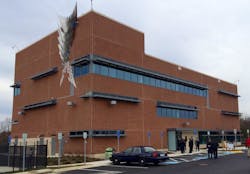Metro Transit Police on Dec. 20 dedicated the new Metro Transit Police District II Police Station and Range Training Facility to the department’s first officer to be lost in the line of duty, Officer Harry Davis, Jr.
Officer Davis passed on December 20, 1993 – five days before Christmas, 21 years ago – after being mortally wounded while investigating a suspicious vehicle near the Landover Metrorail station. The assailant was convicted of first-degree murder and sentenced to life in prison without the possibility of parole.
Officials and family members of Officer Davis unveiled a special MTPD plaque this morning during a dedication ceremony at the new MTPD District II Police Station, followed by a tour of the administration and range training facilities.
Metro Transit Police Chief Ronald A. Pavlik was joined by the family of Officer Davis, MTPD officers and local officials, including incoming Metro Board Chair Mort Downey, Fairfax County Supervisor Jeff McKay, and Fairfax County Supervisor and Metro Board Member Catherine Hudgins. Also in attendance at the event was Chief Polly Hanson, who led the Metro Transit Police Department from 2002 through 2007 and is currently the chief of Amtrak Police.
“The new District II police station will serve as a permanent memorial to Officer Harry Davis, Jr. who faithfully served our community with courage and honor,” said Metro Transit Police Chief Ronald A. Pavlik. “I am pleased that Officer Davis’ family could be here for this special dedication and want to reiterate that his contributions and sacrifice to this Department will forever be acknowledged and remembered.”
Replacing an existing police facility near Huntington, the three-story MTPD District II police station is located on 26 acres of Metro property, one quarter mile from the Franconia-Springfield Metrorail station.
"The construction of the Harry Davis, Jr. Metro Transit Police Department police station and range training facility is another great example of regional collaboration between our Local, State, and Federal partners to deliver an excellent product for our customers and employees,” said Fairfax County Supervisor and Metro Board Member Catherine Hudgins.
About 140 officers and support personnel will be assigned to the police station. The officers working out of the station have an expansive patrol service area that includes several Metrorail lines and bus routes, three rail yards and three bus garages. The District II patrol area extends from Metro Center and Gallery Place, south through the District of Columbia and parts of Prince George’s County, as well as all of Northern Virginia.
Adjacent to the station is a 33,000-square-foot range training facility – a first of its kind for the department – featuring two separate firing ranges with twelve lanes each. The range training facility is an important addition to the department, because it provides a dedicated range facility for officers to receive important instruction and training without having to use the resources of other law-enforcement agencies.
“I’m proud to have this Metro police station and range training facility—the first of its kind built for the Metro Transit Police Department—in Lee District,” said Fairfax County Supervisor Jeff McKay. “The community welcomes this environmentally advanced facility and its economic benefits to local businesses and increased sense of security.”
Construction on the Metro Transit Police Harry Davis, Jr. District II Police Station and Range Training Facility began in 2013.
The facility was designed to be environmentally friendly and is expected to achieve LEED Silver certification. In addition to heat and energy recovery systems, the new buildings are constructed with a light-colored roof to reflect heat and save energy consumption, high-efficiency fixtures to save water, motion sensors to turn lights on and off automatically and parking for fuel-efficient vehicles to reduce pollution from automobile use.


